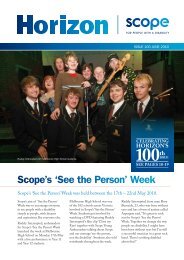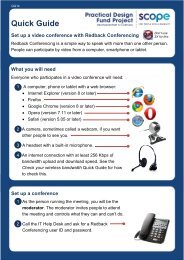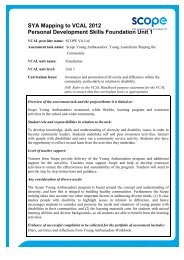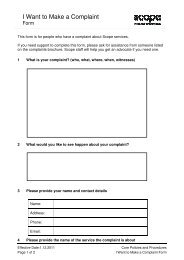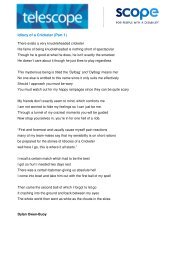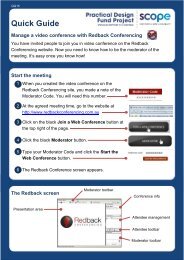Positive behaviour support Getting it right from the start
Positive behaviour support Getting it right from the start
Positive behaviour support Getting it right from the start
You also want an ePaper? Increase the reach of your titles
YUMPU automatically turns print PDFs into web optimized ePapers that Google loves.
60 <strong>Pos<strong>it</strong>ive</strong> <strong>behaviour</strong> <strong>support</strong>: <strong>Getting</strong> <strong>it</strong> <strong>right</strong> <strong>from</strong> <strong>the</strong> <strong>start</strong> - Facil<strong>it</strong>ators reference manual<br />
PowerPoint 84<br />
PowerPoint 85<br />
*<br />
*<br />
Step 2: What happens, before, during and after <strong>the</strong> <strong>behaviour</strong>?<br />
Now that we know what <strong>the</strong> <strong>behaviour</strong> is, we need to ga<strong>the</strong>r as much information as possible<br />
about <strong>the</strong> <strong>behaviour</strong>.<br />
• What happens before <strong>the</strong> <strong>behaviour</strong>? (Setting events: triggers and warning signs)<br />
• What happens during <strong>the</strong> <strong>behaviour</strong>? (Action: What did <strong>the</strong> person actually do? What did <strong>it</strong><br />
look like?)<br />
• What happens after <strong>the</strong> <strong>behaviour</strong>? (Results: What is <strong>the</strong> person getting <strong>from</strong> <strong>the</strong> <strong>behaviour</strong>?)<br />
It is not necessary here to be able to identify exactly what triggered <strong>the</strong> incident. This is<br />
sometimes difficult. Our task is to take careful note of relevant events that preceded <strong>the</strong> episode.<br />
By doing this we will often be able to uncover patterns in <strong>the</strong> <strong>behaviour</strong>. As mentioned earlier,<br />
<strong>behaviour</strong> is often predictable: that is if A happens B will follow.<br />
Setting events, triggers and warning signs<br />
In identifying setting events <strong>it</strong> is important to consider possible background factors. What was<br />
happening in <strong>the</strong> environment? Where did <strong>the</strong> <strong>behaviour</strong> occur? Who was <strong>the</strong>re at <strong>the</strong> time?<br />
General setting events<br />
The following events may influence whe<strong>the</strong>r <strong>the</strong> <strong>behaviour</strong> occurs.<br />
Factors external to <strong>the</strong> person<br />
• Staff changes<br />
• Level of structure in <strong>the</strong><br />
environment<br />
• Activ<strong>it</strong>y levels in <strong>the</strong> environment<br />
• Level of stress or tension in <strong>the</strong><br />
environment<br />
• Isolation<br />
• Noise levels.<br />
Action<br />
Factors internal to <strong>the</strong> individual<br />
• Pain<br />
• Hunger<br />
• Stress<br />
• Tension<br />
• Depression<br />
• Tiredness<br />
• Frustration<br />
• Medical factors (medical<br />
cond<strong>it</strong>ions, medication and<br />
side effects).<br />
Warning signs that <strong>the</strong><br />
individual displays to indicate<br />
that something is not qu<strong>it</strong>e <strong>right</strong><br />
• Person w<strong>it</strong>hdraws<br />
• Repet<strong>it</strong>ive questioning<br />
• Facial expression changes<br />
• Mood changes<br />
• Pacing<br />
• Over activeness<br />
• Difficulty attending to task.<br />
Describing what <strong>the</strong> person actually did? What did <strong>the</strong> <strong>behaviour</strong> look like?<br />
Examples:<br />
• Person used left fist to h<strong>it</strong> co-resident Mary on <strong>the</strong> head twice.<br />
• Banged back of head on wall five times.<br />
• Picked up television w<strong>it</strong>h both hands and threw <strong>it</strong> towards <strong>the</strong> window. The window did<br />
not break.<br />
• Person picked up chair w<strong>it</strong>h both hands and threw <strong>it</strong> across <strong>the</strong> k<strong>it</strong>chen towards staff member.<br />
Results: Identifying <strong>the</strong> result or outcome is about developing an understanding of what <strong>the</strong><br />
person is getting <strong>from</strong> <strong>the</strong> <strong>behaviour</strong> that motivates <strong>the</strong>m to do <strong>it</strong> again and again that is what<br />
happens following <strong>the</strong> <strong>behaviour</strong> that achieves an important result for <strong>the</strong> person.



